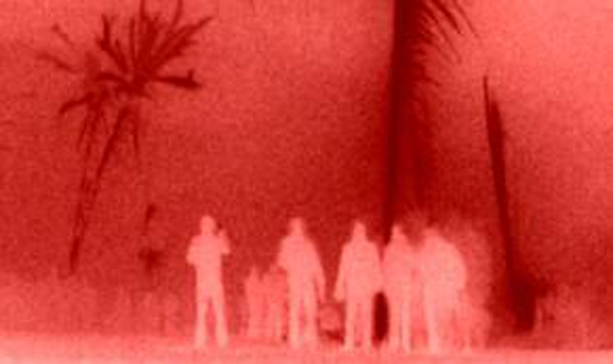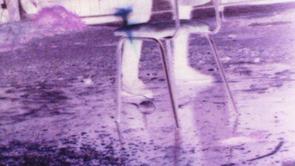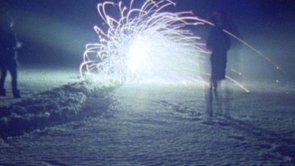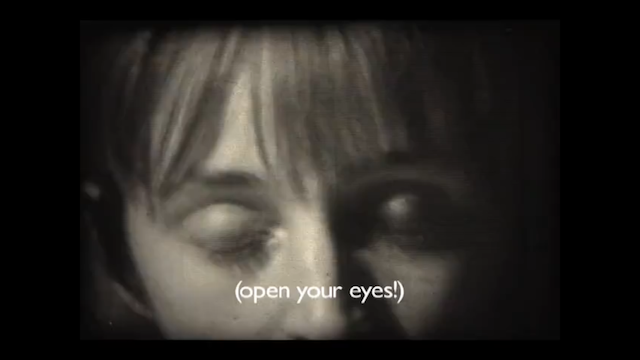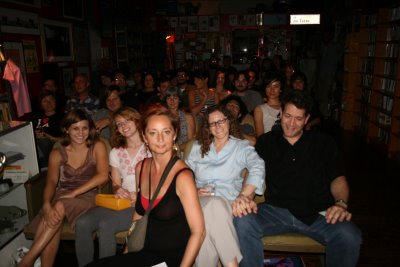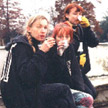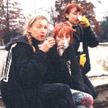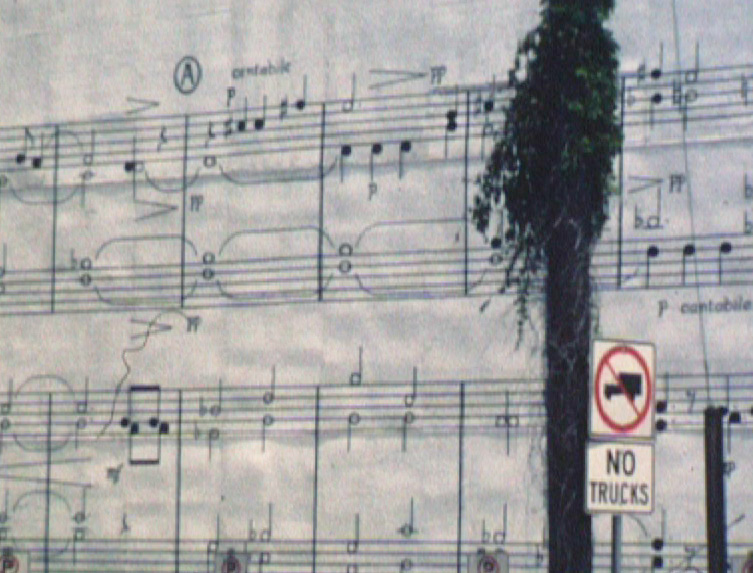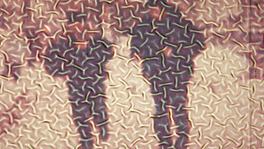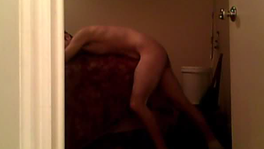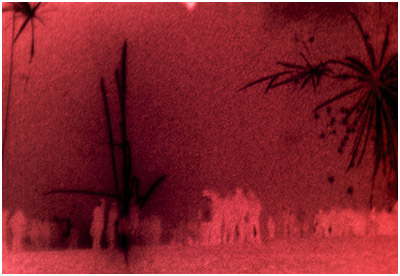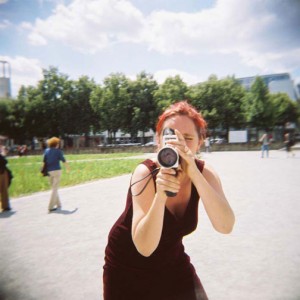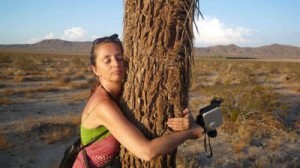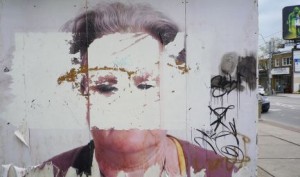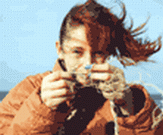
Ladies and Gentlemen, The FBI (Freie Berliner Ischen: Ramona Welsh, Pamela Homann and Dagie Brundert
RW: I was born in East Berlin and lived there until 1989. I was part of an underground group called Medea. We performed plays, made music and films. While none of our work was directed specifically against the government we had trouble because we spoke our own language, had own ideas. So the government thought we were against them.
MH: What kind of troubles?
RW: I wanted to go to high school and was told I wasn’t wanted. Some of the people in the group were in a special high school for actors and got chased out. Dirk went to jail because one day he went crazy and tried to go over the wall but not in the right way (laughs).
MH: Tell me about your performances.
RW: We played with the possibilities of presentation—mixing films and music and theatre in different combinations. Ten years ago Medea was an important voice because we were saying things, exploring events, that others didn’t dare. My first film Konrad Spoke The Woman Mama (12 minutes 1989) used film material from my father, home movies, which I mixed with an industrial film from a 1950s hospital about autistic children. I got the movie from a friend of mine who worked in a hospital. The cutting is very quick, but I lacked a cutting machine, so I used scissors and scotch tape, holding the film up to the light to see it. In joining this private and public material the sick person looked like a little Buddha while the family looked ill. I wanted to change the idea of ‘normal.’ The title is a quote from a book about a boy who never washed, or cut his nails. It’s about a bad child.
MH: Did you begin making films because of this home movie footage?
RW: It came as a complete accident. I wanted a still camera and asked a friend in the West if he could send me one. But instead he sent me a super-8 camera. You could buy Russian film very cheaply, it cost about eleven GDR marks for a roll of b/w film which included processing ($2 US). But eventually we started to process the work ourselves because of the lab problems.
PH: Ramona was registered as a complicated or dangerous person with the Stasi, the secret police. Their lists circulated to many places, including the film labs.
RW: All of the filmmakers in the GDR had trouble with the labs. It’s not that they would look at your material and find some of it offensive and lose it, it would just happen that rolls would be destroyed, or over processed, or sorry we had an accident. Anything to discourage production by the wrong people.
MH: Did you work with other members of the group?
RW: Yes, I made Vergessener Sex (12 minutes 2-projectors 1989) with two gay men. We photographed what turned out to be the last big state parade before the wall came down. It’s a great celebration of communist ideals, with marching soldiers and flags and government officials posted on high. This film follows a young man through the parade which occasions a dream. When he falls into his dream the second projector begins. He dances with his boyfriend in an open field where they have sex together. The GDR was very opposed to gay life and we tried to explain this in the movie.
I also made Arzgebirg, How Nice You Are (10 minutes 1989). Arzgebirg is a mountain range in Eastern Germany where my grandparents lived. I went often as a child and have very fond memories. But in the 1950s the USSR converted it into a dump site for radioactive uranium used in atomic bombs. So the area is a little dead now, dead trees, dead people. This wasn’t shown directly, instead it was made like a music video…
PH: In order to say good-bye.
RW: A week before the wall came down I made a green card marriage and moved to Zurich. Then the wall came down and I thought about staying in Switzerland but at this moment when the systems came together I thought I have to come back and try to live there. I had many film shows in Germany. It was the first time I wasn’t an underground filmmaker, I could show in cinemas not just in forbidden places. It was illegal to show this work in the GDR, but now everyone was interested because of its novelty. I was invited to the United States and toured from east to west. I met Stan Brakhage there, the king movie father of the American underground. Then I came back and two years ago the FBI began. Dagie had already been making films and Pamela also came from GDR. We didn’t always want to be making our films alone. We wanted to reach people in another way. It was magic.
DB: We were angels for each other.
PH: At the same time we had the same idea.
DB: That was in September. Two weeks later we had our first program.
RW: It was like dynamite.
PH: I didn’t make films in the GDR. Instead, I knew a group in Potsdam (Film Und Photo Man Ray) who were producing and I’d help out. But it was always very difficult for them—to make and to show. I was just a viewer, an interested visitor. When I lived there, something was happening inside me which stopped, so it had to wait until later, until the West. When I moved I got my first super-8 camera and made pictures of my first travels in the West, just to make movies. I made connections in Berlin with other people making super-8, and worked in the first film theatre in Germany devoted to short films. We organized program and special screenings and that’s where I met Dagie. In 1991. I’d been making films but when FBI started I made many more. It was inspiring.
DB: The coincidences that brought us together! Cha cha.
PH: I made a program of Dagie’s films for an August screening in the former GDR. It was a screening held in a backyard and later that day I was approached by Hans who said he was opening a new place—the Aktion Galerie and invited us to show films. They wanted to have a new exhibition every week, to invite DJ’s, actors, filmmakers, painters, everyone.
RW: It was the right time and the right place for us.
DB: We drank a lot of red wine in a truck on the way back and talked it over.
PH: And so we became the most regular part of the Aktion Galerie, the house band. For myself, I came to see films in a lighter way, that film could be fun and made cheaply and that you can do whatever you want. All of a sudden there were no rules. I made a film called He Goes And He Sings (4 minutes 1995). It shows a blind man who travels, sings, finds a woman, loves her, and then he goes away.
DB: Yeah, a true story.
MH: Tell me about the first FBI show.
RW: It was a mix of our movies and others. I showed a movie in London called Australia-New Zealand-Berlin in London (8 minutes 1991-94). It’s a very girl film made with the young people I was living with in a London squat. Each of us came from different countries, hence the title. The film depicts a girl who comes to London, tries to meet someone and can’t, but meets instead another girl on a bus. They argue and follow each other around London, and in the end they’re still fighting. Somehow they’re the same person.
DB: The gallery was full—about fifty people. It was a great feeling.
RW: High feeling.
DB: Then we planned to do it every month and thought of themes for each show. Like homework. Like the fish and chips theme.
RW: That’s when I made Fish in Toscana (3 minutes 1995). I needed to make a film for this program but I was in the middle of a forest in Toscana. So I showed people going to the forest to fish, eventually catching some handmade fish. A shark arrives and follows them through the woods.
DB: I already had some fish films in my repertoire. Like Fish Release (5 minutes 1994). I’d set my goldfish free in a lake, a magical ritual which involved the three of us, just a month after we met. It’s self processed on Russian color stock but the chemicals were too old so you can’t really see the image. You see a strange orange color and the shapes of things moving behind.
RW: I had a bad break with a partner. He fell in love with my girlfriend so I took my son and left for holidays. We flew to Grand Canal and there I made a fish movie. You see fish bones alone, and then finding each other, and they make love in the sun, with dragons flying in the sky. That’s Night and Day (6 minutes 1995).
DB: At first we made a program every month but it became too much to produce so much. Now we screen every two months. We’ve done eighteen programs so far, usually in the Aktion Galerie. We like to have the projector in the room, to talk before each of the films.
PH: We can create our own atmosphere.
DB: The Galerie is a small place in the cellar, a kind of catacomb which is perfect. And we do things. For an Italian program we made spaghetti. For our spring program we made rose wine with red leaves inside, and fish soup for our fish program. The audience loves it as we do. A true circle of inspiration.
MH: How did you get started Dagie?
DB: I began in 1988 as a specialist in animated films, and I thought I would make these films forever. What I loved about super-8 was that I could work alone at home with cheap equipment. And my love for plastic figures and animals comes in part because they’re so easy to direct, they never say no, never tire. But how did it all begin? I was in high school with a friend and somehow by accident our prof showed us his super-8 camera. We thought it would be a good idea to make a film. Later we chanced upon a tableful of Barbies in a cheapshop and had to buy them. We had 23 DM which bought 23 Barbies. We eventually lined them up against a wall and had them fall to their death one at a time. That was 23 Barbie Dolls Collapse (3 minutes 1988). And so I became an addict.
I continued making animated films, providing new views of everyday things. For instance in Cowboy Ride Faster (2 minutes 1989) I worked again with a normal children’s play thing, a cowboy on a horse. Then I saw that the cowboy was attached to his horse with a plastic cock pushed up his ass, and that gave me a new dimension on why Indians are so interested in cowboys. There’s a hand drawn background which scrolls past as the cowboy rides, he gets off and then the Indian comes to examine this strange horse’s cock.
There are people who know I like toys, especially plastic men and women, which they collect and give to me. That’s how The 6 Astronauts (6 minutes 1991) began, as a gift. I wondered how they would look at my personal surroundings, like mineral water in a glass, or bread with jam, or my fridge and alarm clock, these small moments of my life which appear monstrous to them. The film simply shows a day in the life of these astronauts exploring a different world. The other half of the film is the sound which arrives in miraculous ways. I do the picture first and the sound just seems to come, that’s the spirit of super-8, I hear a piece of music and think that’s exactly what I need.
Some years later I began making films with people like Ruminate In The Age of Totally Acclimatized Space Helmets (6 minutes 1994). It began with a technical question: how precisely could I scratch onto a super-8 frame? I took a small needle which I heated with a candle and scratched a helmet around the head of the main actor. It took a long time. The film shows a woman landing here in Berlin who continues to receive messages from outer space. She finds papers with hieroglyphic messages which lead her to new adventures—each of these messages is a kind of riddle. She’s on a roof when small papers drop from an airplane. She reads these magic poems, turns and chants and a man appears. Unfortunately he’s 62 years old. Disappointed she picks up another paper which reads 62 divided by 2 is 31. She conjures sparks from her fingers and the old man splits into two different fellows, each 31 years old (her own age). She leaves with both. That was my first romantic film. Of course I’d just split with my boyfriend so this was a very personal film.
Then I started with self developing. Some months before the wall came down you could buy cheap GDR film. I bought a Russian tank for processing and made experiments, processing color films in b/w chemicals, learning by doing. More than half the films since then were hand developed, everything except for Kodachrome. I liked the accidents very much. You shoot the film in the day, develop that evening and the next day begin to listen for the soundtrack. And working with the FBI made the films flow much quicker, there was already a subject because we would decide on a theme, and a date for the next show. We do the shows Monday and Tuesday and the weekend before we don’t sleep a lot, just too busy making films. It’s very inspiring.
The film Ischtar, Goddess of Love (4 minutes 1996) came out of a Gods and Goddesses theme. It was wintertime, and walking around a Berliner park I saw children sleigh riding. I turned the camera upside down and processed as negative so black was white in this upside down world. Then I needed a person and I was available so I thought, why not? I played Ischtar (from the verb ‘to be’) a Babylonian goddess alive thousands of years ago, who held the strings of the world in her hand. She could change the world from positive to negative just by loving. She could use her charms to develop—films, the world, to change the world by playing. She paints a heart on her forehead because “simple people need symbols,” she says, “so if you want to see sleighs running down the mountain, if you don’t want to reproduce written language, just go ahead and start loving each other.”
Oh It’s Nice To Be A Beetle (3 minutes 1996) showed two beetles in the grass who wonder what it would be like to be different. Both have numbers on their chest. Beetle One says, “Sometimes I’d like to be a wild dog and run where I want.” Then you see a dog running about-catching sticks over and over again. Beetle Two says, “No, they’re not as free as you think. But sometimes I would like to be a conductor for the railway because I like to bite holes in tickets.” And Beetle One responds, “It isn’t like that anymore, they print numbers on their tickets now.” And then both sing their It’s Nice to be a Beetle song.
MH: Are many folks working in super-8?
PH: They’re not in one place.
DB: It comes in waves. Two years ago there was hardly anyone. Now it begins again.
PH: Some made films inspired by our programs. We announce our theme two months in advance and invite anyone to participate.
MH: How did you find your name?
DB: It means Free Berliner Wild Women—something like that. It happened quite by accident. When we met we took our cameras into the park to make our first trailer and I was wearing this jacket (she shows her FBI jacket) which I got because I loved agent Dale Cooper from Twin Peaks. So we decided to become the FBI. It was magic.
Originally published in: Millennium Film Journal Nos. 30/31 (Fall 1997)
